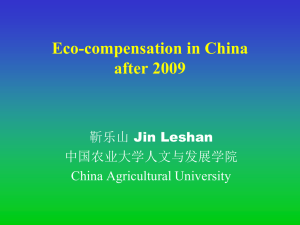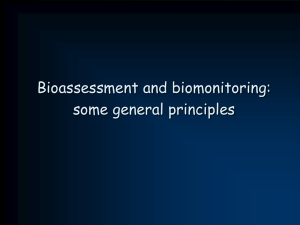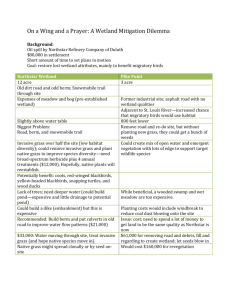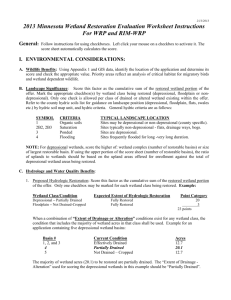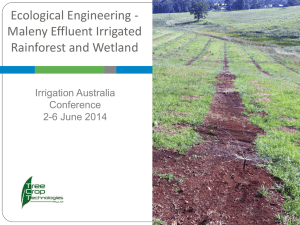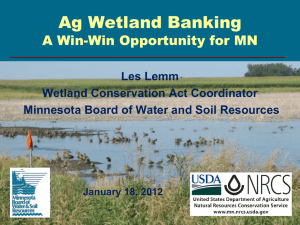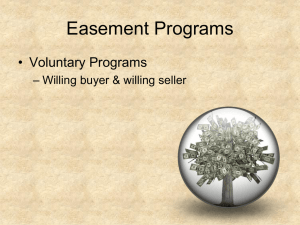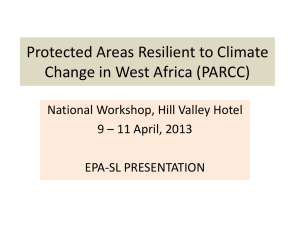Main Streams of Life (MSL) - Wetland PA Programme 生命主流化
advertisement
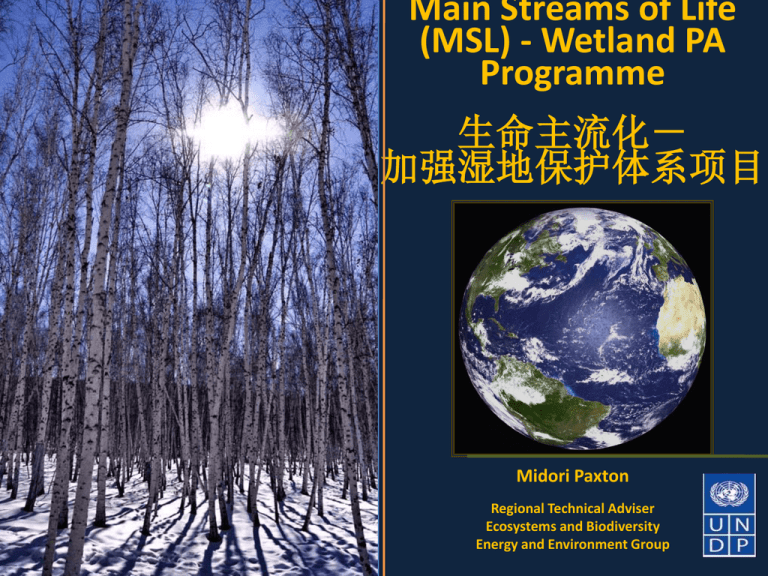
Main Streams of Life (MSL) - Wetland PA Programme 生命主流化- 加强湿地保护体系项目 Midori Paxton Regional Technical Adviser Ecosystems and Biodiversity Energy and Environment Group Outline 主要内容 1. Overview of the CBPF-MSL Programme 中国生物多样性伙伴关系框架-生命主流化 项目(CBPF-MSL)简介 2. Project Preparation Grant (PPG) Phase 项目文件编制阶段(PPG) 3. Technical Requirements for the Formulation of Final Project Documents 项目最终文件编制技术要求 GLOBAL ENVIRONMENT FACILITY -GEF-全球环境基金 Global financing mechanisms for multilateral environmental agreements – e.g. CBD, UNFCCC 多边环境公约全球资金机制-例如,生物多样性公约、 联合国气候变化框架公约 GEF-5 Replenishment – US$ 4.248 b. 第5增资期-42.48亿美元 STAR Allocation for China 资源透明分配体制共分配给中 国2.1169亿美元 Total: $ 211.69 million - US$ 149.6 million for CC 气候变化 - US$ 52.67 million for BD 生物多样性 - US$ 9.42 million for LD 土地退化 China’s PA Network and Wetlands 中国保护地网络与湿地 > 2,500 NRs 2500多个自然保护区 553 “wetland NRs” 92 national 553个湿地自然保护区,其中,92 个为国家级 37 Ramsar sites 37个国际重要湿地 Majority of NRs administered by the SFA 大多数自然保护区由国家 林业局主管 Other NR agencies – MEP, MLR, MOA and SOA - >10 其他自然保护 区管理机构包括环保部、国土资源 部、农业部和国家海洋局等10余家 National, provincial, municipal & county NRs 自然保护区按保护等级 可分为国家级、省级、县市级 Regulation on Nature Reserve Management (1994)《 自然保护区 管理条例》(1994) Main Stream of Life (MSL)生命主流化 Wetland PA Strengthening Programme 加强湿地保护体系项目 under the CBPF Objective: Catalysing the Sustainability of National Protected Area System for Conservation of Globally Significant Wetland Biodiversity 目标:加强中国保护地体系,保护具全球重要性的湿地生物多样性 1+6 US$ 26 million 1国家级项目+6个省级项目 2600万美元 Lessons: 经验 • Site level intervention not sustainable;项目点的介入不可持续 • higher level issues; 更高层次的问题 • GEF – system focus GEF-注重系统 Guiding Principles and Features 指导原则与特点 Ensuring linkages and concerted impacts 确保联动和影响一致 Three-tier Approach Provincial level projects to ensure capacity development on the ground / demonstration 三级方法-省级层面的项 目为实地能力建设示范项 目提供保障 Guiding Principles and Features 指导原则与特点 Cost effectiveness : 成本效益 - System Focus 侧重于整个体系 - Catalysing sustainability 加强整个保护地体系的可持续性 of PA system as a whole Cross-fertilisation projects 项目间互相借鉴 between Programme Outcomes Component 1: Systemic and Institutional Capacity at National and Provincial Level • Effective governance and legal framework for the national wetland PA sub-system METT Approved national systems plan for wetlands New PA categories suited for wetland protection exclusive jurisdiction of SFA over core zone of NNR for conservation purposes • Coverage of natural wetlands 50.3% to 55% (+1.7 million ha) • BHI in place; higher budget, technical capacity and up-to-date information and data to be channelled quickly to wetland PAs improving management effectiveness. • Improved protection of threatened species e.g. Chinese beaver, moose, Yangtze crocodile, finless porpoise and redcrowned crane etc.) through increase in coverage and mgt effectiveness Programme Outcomes Component 2: Mainstreaming Wetland PAs • • • • National PA system management mainstreamed within national and provincial development planning framework - 13th 5-year plan and sectoral plans, PA mgt standards Safeguards from sector practices in and near wetland PAs in the long term reducing pressures on biodiversity from agricultural; industrial and mining-related pollution; IAS threat; habitat change including water related disturbances from dams Increased national and provincial governmental budget allocations: an increase of >50% over baseline amount of $300 million/per year. Reduction of funding gap for model PA due to improved planning and budget allocation efficiencies; increased revenues; diversified funding sources and reduced cost from threat reduction at source etc. Programme Outcomes Component 3: Knowledge Mgt and Lessons Sharing • Strengthened data sharing system: open access knowledge management platform, being routinely updated by wetland sites and used by planners and in EIA procedures, uptake of knowledge and replication of management practices from the provincial projects to similar types of wetland county wide (replication targets to be set during PPG) • Improved understanding among decision makers and the public on value of wetlands and PA system: KAP survey Project Development Where we are CBPF-MSL Programme Framework Document and national level project approved and included in the GEF November WP Altai PA network project (Xinjiang) PIF approved and included in the February inter-sessional WP Hainan, Daxing’anling, Honghu, Shenjinghu and Poyang Lake Project (FAO) PIFs approved and included in the June 2012 work programme. All the PPGs submitted. 4 approved. US$ 577,615 US$ 127,125 (FAO) US$ 704,740 Consultants recruited PPG Process and Timeline 项目文件编制阶段流程和工作时间表: Info/data gathering, consultation, assessments May - July Draft ProDoc 起草项目最终 文件初稿 Aug – Sept. 8-9月 Gov. Final Draft ProDoc & &UNDP CEO Doc, BD-1 TT review Sept/Oct 政府和 联合国 UNDP Technical 计划开 发署评Clearance 审 Project Submission to Translation! GEF SEC – Oct./Nov GEF SEC Review 18 10-day business standard Project Re-submission to GEF SEC Nov/Dec Project Initiation by May 2013 Signed Project document Feb 2013 CEO endorsed documents Dec/Jan, 2013 PPG Activities 项目文件编制活动 1. Systemic/ Institutional Capacity 2. Analysis of National dev. & sector planning process 9. Feasibility analysis and budget 8. Financing needs, METT and PA site profiling 7. Knowledge, Attitude and Practice Survey, community participation/gender assessment Pro Doc CEO Doc 3. Wetland PA subsystem Profiling BD-1 TT 4. Economics component design 6. PA Info. & Data Mgt System 5. Wetland BD Health Index PPG Inputs 项目文件编制专家配置 CEO Endorsement Request and Project Document 项目文件批准申请与项目文件 • Requires detailed baseline information and in-depth analysis to make the case • 需要详细的基线信息及深入的分析 • Logframe – indicators, baseline values, targets, results measurement methods must be established • 逻辑框架—必须确定指标、基线值、目标、结果测量 方法 CEO Endorsement Request and Project Document 项目文件批准申请与项目文件 • Business as-usual-scenario and incremental benefits must be defined • 必须确定常规结果及GEF基金投入后的增值结果 • Global biodiversity benefits must be elaborated and concretised. • 详细具体地分析项目点的生物多样性的全球重 要性 UNDP Project Document 联合国开发计划署项目文 件 PART I: Situation analysis – context & global significance , threats, long-term solution, stakeholder analysis, baseline analysis 第1 部分:现状分析-背景与全球重要性,威胁,长期解决方案,利益相关者分 析,基线分析 PART II: Strategy – project rationale and policy conformity, Goal, objective, outcomes and outputs, outcome indicators, risks and assumptions, country ownership, sustainability, reliability 第2部分:策略-项目立项理由,政策可行、大目标、小目标、 成果与产出、成果指标、风险分析及分析前提、国家支持、可持续 性,可靠性 PART III: Mgt Arrangement 第3部分:项目管理 UNDP Project Document 联合国开发计划署项目文 件 PART IV: M&E Plan 第4部分:监测评估计划 Strategic Results Framework 战略成果框架 Incremental Cost Analysis 增值成本分析 Budget and Workplan 预算与工作计划 Additional Information - Co-financing letters, PA profile, community profile, ToRs 其他信息:配套资金确认函、保护地概况、当地社区概况、工作任务书(ToRs) CEO Endorsement Request 项目文件批准申请 • Most of ProDoc elements Project Framework 包括项目最终文件的 主要部分,项目框架 • Financial summary tables 资金汇 总表 • Explanation re. alignment with original PIF 与项目确认书一致 • Response to GEF SEC, STAP and Council comments回复GEF秘书处 、科学技术顾问组及成员国的问 题 • PPG implementation report 项目 文件编制实施报告 Annexes & GEF BD-1 Tracking Tools 附录与GEF生物多样性-1跟踪工具 Tracking Tool for Biodiversity Projects in GEF-3, GEF-4, and GEF-5 Objective 1: Catalyzing Sustainability of Protected Area Systems SECTION II: Management Effectiveness Tracking Tool for Protected Areas Note: Please complete the management effectiveness tracking tool for EACH protected area that is the target of the GEF intervention. Structure and content of the Tracking Tool - Objective 1. Section II: The Tracking Tool has two main sections: datasheets and assessment form. Both sections should be completed. 1. Datasheets: the data sheet comprises of two separate sections: Data sheet 1: records details of the assessment and some basic information about the site, such as name, size and location etc. Data sheet 2: provides a generic list of threats which protected areas can face. On this data sheet the assessors are asked to identify threats and rank their impact on the protected area. 2. Assessment Form: the assessment is structured around 30 questions presented in table format which includes three columns for recording details of the assessment, all of which should be completed. Important: Please read the Guidelines posted on the GEF website before entering your data Data Sheet 1: Reporting Progress at Protected Area Sites Please indicate your answer here Notes Data Sheet 1: Reporting Progress at Protected Area Sites Please indicate your answer here Notes Name, affiliation and contact details for person responsible for completing the METT Zhang Dehai(Dupty director (email etc.) of the PA) Date assessment carried out Month DD, YYYY (e.g., May 12, 2010) Oct . 15, 2010 Qinghai Sanjiangyuan Name of protected area National Nature Reserve WDPA site code (these codes can be found on www.unep-wcmc.org/wdpa/) 1: National Designations(please choose 1-3) 1 2: IUCN Category 3: International (please complete lines 35-69 as necessary ) Country China Location of protected area (province and if possible map reference) Qinghai Province 2,003 Date of establishment 1: 1 2: 3: 4: Ownership details (please choose 1-4) Management Authority Size of protected area (ha) Number of Permanent staff Number of Temporary staff Annual budget (US$) for recurrent (operational) funds – excluding staff salary costs Annual budget (US$) for project or other supplementary funds – excluding staff salary costs What are the main values for which the area is designated List the two primary protected area management objectives in below: Management objective 1 Management objective 2 No. of people involved in completing assessment Including: (please choose 1-8) State Private Community Other Qinghai Sanjingyuan NR Management Bureau 152300 Km2 13 80,000US$ 700,000US$ Wetland protection and biodiversity conservation Wetland protection Biodiversity protection 5 1: PA manager 2: PA staff 3: Other PA agency staff 2 4: Donors 5: NGOs 6: External experts 7: Local community 8: Other • METT 管理有效性跟踪工具 • Financial Sustainability Scorecard 资金可持续性记分卡 • Capacity Development Scorecard 能力建设记分卡 Things to bear in mind….. 请切记 • Strong team leader and tight teamwork • 项目组长卓越的领导能力和紧密的团队合作 • Knowing what information/data/analysis are required in each section from the beginning在项目文件编制之前即清楚地知道项 目文件各部分的编写需要哪些信息/数据, 及应进行何种分析 • Project design is in PIF – add flesh to the skeleton项目框架就是项 目确认表(PIF)—用详细的数据丰富项目框架 • Define clear baseline and targets 明确基线和目标 • Full consultation and identification of local champions • 找出当地“领袖人物”,并全面征求他们的意见 • Implementable plan with sufficient guidance – e.g. build on baseline activities, detailed local information, full ToR, results measurement methods etc. 详细的实施计划-这一计划是以现 有的活动、详细的当地信息、详尽的工作内容、结果评估方法 Thank You! 谢谢

